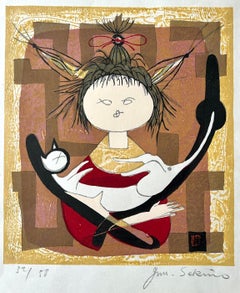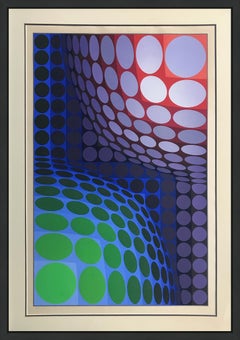Junichiro Sekino Figurative Prints
Jun'ichiro Sekino was born in Aomori Prefecture, Japan, in 1914. He began making wood print art while still in middle school before formally pursuing etching with Kon Junzo. Active in the print scene, Sekino participated in the Chokojuto (1932) and Shin Hanga (1935) art shows, and exhibited with the Nihon Hanga Kyokai group as well. After winning the Teiten prize for etching in 1936, he moved to Tokyo in 1939. Jun’ichiro Sekino continued his studies at the Etching Institute of Takeo Nishida, where he also trained in oil painting and drawing.
Sekino commenced his study of woodblock prints with Koshiro Onchi and soon joined the Nihon Hanga Kyokai during the 1930s, followed by the Kokugakai in 1940. He exhibited worldwide, winning particular acclaim in the United States for his woodblock prints following World World II. In 1958, the Japan-America Society brought Sekino to the United States, where he taught at Oregon State University in 1963. Upon returning to Japan, he assumed a position at Kobe University in 1965 and received the medal of the Imperial Household Agency in 1981. Sekino’s work is greatly inspired by old Japanese and European masters alike, such as Sharaku and Albrecht Durer. The subject of his work varies, although he commonly focused on portraits, landscapes and semi-abstract designs. Jun'ichiro Sekino passed away in 1988.
20th Century Showa Junichiro Sekino Figurative Prints
Paper, Etching
20th Century Showa Junichiro Sekino Figurative Prints
Paper
1950s Modern Junichiro Sekino Figurative Prints
Woodcut
2010s Contemporary Junichiro Sekino Figurative Prints
Paper, Screen
1970s Op Art Junichiro Sekino Figurative Prints
Paper, Screen
1970s Other Art Style Junichiro Sekino Figurative Prints
Woodcut, Paper, Ink
1930s American Modern Junichiro Sekino Figurative Prints
Woodcut
1970s Modern Junichiro Sekino Figurative Prints
Printer's Ink, Archival Paper, Etching
2010s Pop Art Junichiro Sekino Figurative Prints
Metal
1970s American Modern Junichiro Sekino Figurative Prints
Woodcut
1980s Contemporary Junichiro Sekino Figurative Prints
Paper, Ink, Engraving, Etching, Aquatint, Screen
1950s Surrealist Junichiro Sekino Figurative Prints
Paper, Etching, Aquatint
1960s Modern Junichiro Sekino Figurative Prints
Cardboard, Paper, Screen
Phillip Herschel Paradise"Golden Haven" - Mid Century Modern Dual Panel Vertical Serigraph , c.1960s
1970s American Modern Junichiro Sekino Figurative Prints
Woodcut
21st Century and Contemporary Pop Art Junichiro Sekino Figurative Prints
Paper, Etching
20th Century Showa Junichiro Sekino Figurative Prints
Paper
1950s Modern Junichiro Sekino Figurative Prints
Woodcut
1960s Modern Junichiro Sekino Figurative Prints
Woodcut





